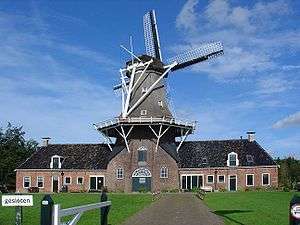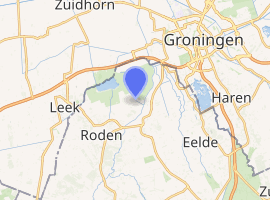Woldzigt, Roderwolde
Woldzigt (Drèents for 'view of the woods') is a smock mill in Roderwolde, Drenthe, the Netherlands. The mill has two functions; a corn mill and an oil mill. It was built in 1852 and is listed as a Rijksmonument, number 32541.[1]
| Woldzigt, Roderwolde | |
|---|---|
 Woldzigt, September 2009 | |

| |
| Origin | |
| Mill name | Woldzigt |
| Mill location | Hoofdstraat 38, 9315 PC, Roderwolde |
| Coordinates | 53°10′14″N 6°28′46″E |
| Operator(s) | Gemeente Noordenveld |
| Year built | 1852 |
| Information | |
| Purpose | Corn mill and oil mill |
| Type | Smock mill |
| Storeys | Three-storey smock |
| Base storeys | Four-storey base |
| Smock sides | Eight sides |
| No. of sails | Four sails |
| Type of sails | Common sails |
| Windshaft | Cast iron |
| Winding | Tailpole and winch |
| Auxiliary power | Petrol engine, later a steam engine |
| No. of pairs of millstones | Two pairs |
| Size of millstones | 1.60 metres (5 ft 3 in) diameter. also a pair of edge runner stones 1.80 metres (5 ft 11 in) diameter |
History
Woldzigt was built in 1852 for S J Datema and E F Aukema. It was built as a corn mill and oil mill combined. The oil mill was used to crush linseed to produce linseed oil and rapeseed to produce rapeseed oil. The season for oil milling ran from September until May. Throughout the year the mill also functioned as a corn mill.[2]
In 1902, the mill was sold to Jan Rietema of Leens. A Deutz petrol engine was installed in that year as auxiliary power. In 1906, the petrol engine was replaced by a steam engine. Rietema worked the mill until 1919 when he left to take the oil mill Tjamsweer at Appingedam, Groningen. The steam engine was removed at that date. The mill was then sold to the coöperatieve olieslagerij en korenmalerij Woldzigt G.A. It was worked by Jan Faber who had been employed at the mill since 1912. During this time the mill was used to produce cattle food and artificial fertiliser. In 1941, the mill ceased to produce oil. The mill was sold to the Coöperatieve Zuivelfabriek Roden-Zevenhuizen in 1945. Jan Faber died in 1946. The mill was then worked by Frederick van der Velde, who had been employed at the mill since 1925. The mill was producing 5,600 kilograms (880 st) of flour per day. Corn milling ended in 1951.[2]
In 1970, the mill was sold to the Gemeente Roden. The Stichting olie- en korenmolen Woldzigt (English: Oil and corn mill Woldzigt Society) was formed. The mill was completerly restored in 1976.[2]
Description
Woldzigt is what the Dutch describe as an "achtkante stellingmolen". It is a three-storey smock mill on a four-storey brick base. The stage is at third-floor level, 10.00 metres (32 ft 10 in) above ground level. The smock and cap are thatched. The mill is winded by a tailpole and winch. The four Common sails, which have a span of 22.00 metres (72 ft 2 in), are carried in a cast-iron windshaft, which was cast by Koning in 1904. The windshaft also carries the brake wheel, which has 72 cogs. The brake wheel drives the wallower (48 cogs) at the top of the upright shaft. At the bottom of the upright shaft the great spur wheel, which has 103 cogs, drives the 1.60 metres (5 ft 3 in) diameter French Burr millstones via a lantern pinion stone nut which has 24 staves. The 1.80 metres (5 ft 11 in) diameter edge runner stones and the stamp mills are driven by lantern pinion stone nuts of 26 and 27 staves.[1][3]
Millers
- S J Datema 1852-1902
- E F Aukema 1852-1902
- Jan Rietema 1902-19
- Jan Faber 1912-46
- Frederick van der Velde 1925-51
Public access
Woldzigt is open all year round on the first Saturday in the month from 13:30 to 17:00. From May to September, the mill is open Wednesdays to Saturdays from 13:30 to 17:00.[4]
References
- "Technische gegevens" (in Dutch). De Hollandsche Molen. Retrieved 6 October 2009. (Click on "Technische gegevens" to view.)
- "Geschiedenis" (in Dutch). De Hollandsche Molen. Retrieved 6 October 2009. (Click on "Geschiedenis" to view.)
- "Roderwolde, Drenthe" (in Dutch). Molendatabase. Retrieved 6 October 2009.
- "Informatie" (in Dutch). De Hollandsche Molen. Retrieved 5 October 2009. (Click on "Informatie" to view.)